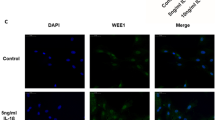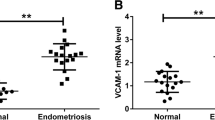Abstract
Although our previous study confirmed that periostin (PN) was overexpressed in the eutopic and ectopic endometrial stroma of women with endometriosis by immunohistochemitry, the role of PN in the pathophysiology of endometriosis remains unknown. Thus, we aimed to investigate the effects of PN on endometrial stromal cells (ESCs) migration, invasion, adhesion, and proliferation and to further study the mechanism under this process. Eutopic (EuSCs), ectopic (EcSCs), and normal ESCs (NSCs) were isolated and cultured. We evaluated the above-mentioned biology behaviors and the expression of PN, integrin-linked kinase 1 (ILK1), and phospho-Akt (p-Akt) in NSCs, EuSCs as well as EcSCs before and after receiving PN small-interfering RNA (siRNA). The protein and messenger RNA (mRNA) levels of PN were upregulated in EuSCs (P < .05; P = .2261 in proliferative phase and P = .3385 in secretory phase) and EcSCs (P < .001; P < .001 in proliferative phase and P < .05 in secretory phase) compared with NSCs, although there was no significant difference in PN mRNA between EuSCs and NSCs. In EcSCs, abilities of migration, invasion, and adhesion and the expressions of ILK1 and p-Akt were enhanced; and all of those were downregulated after PN siRNA interference. Thus, PN enhanced ESCs migration, invasion, and adhesion due to the ILK1/Akt signal pathway. As an agonist in the development and progression of endometriosis, PN may be a new clinical treatment target of endometriosis.
Similar content being viewed by others
References
Giudice LC. Clinical practice. Endometriosis. N Engl J Med. 2010;362(25):2389–2398.
Sampson JA. Peritoneal endometriosis due to menstrual dissemination of endometrial tissue into the peritoneal cavity. Am J Obstet Gynecol. 1927;14(2):422–469.
Lang JH. Cornerstone of study on endometriosis [in Chinese]. Zhonghua Fu Chan Ke Za Zhi. 2005;40(1):3–4.
Ayala Yanez R, Mota Gonzalez M. Endometriosis: physiopathology and investigation trends (first part) [in Spanish]. Ginecol Obstet Mex. 2007;75(8):477–483.
Bruner-Tran KL, Osteen KG, Taylor HS, Sokalska A, Haines K, Duleba AJ. Resveratrol inhibits development of experimental endometriosis in vivo and reduces endometrial stromal cell invasiveness in vitro. Biol Reprod. 2011;84(1):106–112.
Taylor HS, Osteen KG, Bruner-Tran KL, et al. Novel therapies targeting endometriosis. Reprod Sci. 2011;18(9):814–823.
Kong S, Zhang YH, Liu CF, et al. The complementary and alternative medicine for endometriosis: a review of utilization and mechanism. Evid Based Complement Alternat Med. 2014;2014:146383.
Rogers PAW, D’Hooghe TM, Fazleabas A, et al. Priorities for endometriosis research: recommendations from an International Consensus Workshop. Reprod Sci. 2009;16(4):335–346.
Horiuchi K, Amizuka N, Takeshita S, et al. Identification and characterization of a novel protein, periostin, with restricted expression to periosteum and periodontal ligament and increased expression by transforming growth factor beta. J Bone Miner Res. 1999;14(7):1239–1249.
Conway SJ, Izuhara K, Kudo Y, et al. The role of periostin in tissue remodeling across health and disease. Cell Mol Life Sci. 2014;71(7):1279–1288.
Li G, Jin R, Norris RA, et al. Periostin mediates vascular smooth muscle cell migration through the integrins alphavbeta3 and alphavbeta5 and focal adhesion kinase (FAK) pathway. Atherosclerosis. 2010;208(2):358–365.
Liu C, Huang SJ, Qin ZL. Inhibition of periostin gene expression via RNA interference suppressed the proliferation, apoptosis and invasion in U2OS cells. Chin Med J (Engl). 2010;123(24):3677–3683.
Yan W, Shao R. Transduction of a mesenchyme-specific gene periostin into 293T cells induces cell invasive activity through epithelial–mesenchymal transformation. J Biol Chem. 2006;281(28):19700–19708.
Morra L, Moch H. Periostin expression and epithelial–mesenchymal transition in cancer: a review and an update. Virchows Arch. 2011;459(5):465–475.
Cho YH, Cha MJ, Song BW, et al. Enhancement of MSC adhesion and therapeutic efficiency in ischemic heart using lentivirus delivery with periostin. Biomaterials. 2012;33(5):1376–1385.
Ontsuka K, Kotobuki Y, Shiraishi H, et al. Periostin, a matricellular protein, accelerates cutaneous wound repair by activating dermal fibroblasts. Exp Dermatol. 2012;21(5):331–336.
Li J, Zhang H, Wu J, et al. Prognostic significance of integrinlinked kinase1 overexpression in astrocytoma. Int J Cancer. 2010;126(6):1436–1444.
Ahmed N, Oliva K, Rice GE, Quinn MA. Cell-free 59 kDa immunoreactive integrin-linked kinase: a novel marker for ovarian carcinoma. Clin Cancer Res. 2004;10(7):2415–2420.
Okamura M, Yamaji S, Nagashima Y, et al. Prognostic value of integrin beta1-ILK-pAkt signaling pathway in non-small cell lung cancer. Hum Pathol. 2007;38(7):1081–1091.
Yang HJ, Zheng YB, Ji T, et al. Overexpression of ILK1 in breast cancer associates with poor prognosis. Tumour Biol. 2013;34(6):3933–3938.
Hannigan G, Troussard AA, Dedhar S. Integrin-linked kinase: a cancer therapeutic target unique among its ILK. Nat Rev Cancer. 2005;5(1):51–63.
Sakai T, Li S, Docheva D, et al. Integrin-linked kinase (ILK) is required for polarizing the epiblast, cell adhesion, and controlling actin accumulation. Genes Dev. 2003;17(7):926–940.
Edwards LA, Thiessen B, Dragowska WH, Daynard T, Bally MB, Dedhar S. Inhibition of ILK in PTEN-mutant human glioblastomas inhibits PKB/Akt activation, induces apoptosis, and delays tumor growth. Oncogene. 2005;24(22):3596–3605.
Shen L, Liu P, Zhang P, Zhang X, Cui J. Characterization of periostin expression in human endometrium and endometriotic lesions. Gynecol Endocrinol. 2012;28(10):815–818.
Xi G, Hu X, Wu B, et al. Autophagy inhibition promotes paclitaxel-induced apoptosis in cancer cells. Cancer Lett. 2011;307(2):141–148.
Xu YL, Wang DB, Liu QF, Chen YH, Yang Z. Silencing of cofilin-1 gene attenuates biological behaviours of stromal cells derived from eutopic endometria of women with endometriosis. Hum Reprod. 2010;25(10):2480–2488.
Dimitrov R, Timeva T, Kyurkchiev D, et al. Characterization of clonogenic stromal cells isolated from human endometrium. Reproduction. 2008;135(4):551–558.
McBrideS,WalshD,MeleadyP,DalyN,ClynesM.Bromodeoxyuridine induces keratin protein synthesis at a posttranscriptional level in human lung tumour cell lines. Differentiation. 1999;64(3):185–193.
Berger A, Stierkorb E, Nickenig G. The role of the AUUUUA hexamer for the posttranscriptional regulation of the AT1 receptor mRNA stability. Biochem Biophys Res Commun. 2005;330(3):805–812.
Kim CJ, Yoshioka N, Tambe Y, Kushima R, Okada Y, Inoue H. Periostin is down-regulated in high grade human bladder cancers and suppresses in vitro cell invasiveness and in vivo metastasis of cancer cells. Int J Cancer. 2005;117(1):51–58.
Kudo A. Periostin in fibrillogenesis for tissue regeneration: periostin actions inside and outside the cell. Cell Mol Life Sci. 2011;68(19):3201–3207.
Shao R, Bao S, Bai X, et al. Acquired expression of periostin by human breast cancers promotes tumor angiogenesis through up-regulation of vascular endothelial growth factor receptor 2 expression. Mol Cell Biol. 2004;24(9):3992–4003.
Kii I, Nishiyama T, Li M, et al. Incorporation of tenascin-C into the extracellular matrix by periostin underlies an extracellular meshwork architecture. J Biol Chem. 2010;285(3):2028–2039.
Norris RA, Damon B, Mironov V, et al. Periostin regulates collagen fibrillogenesis and the biomechanical properties of connective tissues. J Cell Biochem. 2007;101(3):695–711.
Shimazaki M, Nakamura K, Kii I, et al. Periostin is essential for cardiac healing after acute myocardial infarction. J Exp Med. 2008;205(2):295–303.
Zhu M, Fejzo MS, Anderson L, et al. Periostin promotes ovarian cancer angiogenesis and metastasis. Gynecol Oncol. 2010;119(2):337–344.
Beliard A, Noel A, Foidart JM. Reduction of apoptosis and proliferation in endometriosis. Fertil Steril. 2004;82(1):80–85.
Borg TK, Markwald R. Periostin: more than just an adhesion molecule. Circ Res. 2007;101(3):230–231.
Takagi J, Petre BM, Walz T, Springer TA. Global conformational rearrangements in integrin extracellular domains in outside-in and inside-out signaling. Cell. 2002;110(5):599–511.
Boulter E, Van Obberghen-Schilling E. Integrin-linked kinase and its partners: a modular platform regulating cell-matrix adhesion dynamics and cytoskeletal organization. Eur J Cell Biol. 2006;85(3–4):255–263.
Yin X, Pavone ME, Lu Z, Wei J, Kim JJ. Increased activation of the PI3K/AKT pathway compromises decidualization of stromal cells from endometriosis. J Clin Endocrinol Metab. 2012;97(1):E35–43.
Samartzis EP, Noske A, Dedes KJ, Fink D, Imesch P. ARID1A mutations and PI3K/AKT pathway alterations in endometriosis and endometriosis-associated ovarian carcinomas. Int J Mol Sci. 2013;14(9):18824–18849.
Franco-Murillo Y, Miranda-Rodriguez JA, Rendon-Huerta E, et al. Unremitting cell proliferation in the secretory phase of eutopic endometriosis: involvement of pAkt and pGSK3beta [published online September 6, 2014.]. Reprod Sci. 2014.
Castronovo V, Waltregny D, Kischel P, et al. Achemical proteomics approach for the identification of accessible antigens expressed in human kidney cancer. Mol Cell Proteomics. 2006;5(11):2083–2091.
Kudo Y, Siriwardena BS, Hatano H, Ogawa I, Takata T. Periostin: novel diagnostic and therapeutic target for cancer. Histol Histopathol. 2007;22(10):1167–1174.
Author information
Authors and Affiliations
Corresponding author
Rights and permissions
About this article
Cite this article
Xu, X., Zheng, Q., Zhang, Z. et al. Periostin Enhances Migration, Invasion, and Adhesion of Human Endometrial Stromal Cells Through Integrin-Linked Kinase 1/Akt Signaling Pathway. Reprod. Sci. 22, 1098–1106 (2015). https://doi.org/10.1177/1933719115572481
Published:
Issue Date:
DOI: https://doi.org/10.1177/1933719115572481




